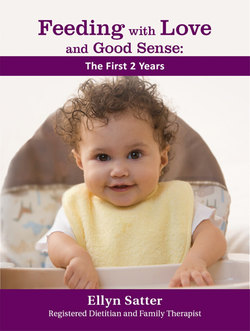Читать книгу Feeding with Love and Good Sense: The First Two Years - Ellyn Satter - Страница 6
На сайте Литреса книга снята с продажи.
Оглавление
1. Where you are going with feeding
Your child’s learning to be a good eater starts at birth. At each step along the way, this booklet addresses your part in his learning—starting with breast- or formula-feeding, going through the steps to learn to eat grown-up food, and joining in with family meals. Step by step, your child learns to eat the food you eat and feel about eating the way you do.
A good eater is a competent eater.
She feels good about eating: Every child wants to eat and can enjoy eating if she gets the right help. Older children who are good eaters enjoy family meals—and their parents do, too.
She eats as much or as little as she needs: Only she knows how much she needs. Trusting her lets her be healthy and energetic and grow up to have the body that nature intended for her.
She eats what you eat with only minor changes: She is okay with being offered food she has never seen before. She can “sneak up” on new food and learn to like it.
She behaves nicely at mealtime: She picks and chooses from what you provide for the meal. She says “yes, please,” and “no, thank you.” She does not make a fuss.
You can raise a good eater.
Follow the division of responsibility. Doing your jobs with feeding and trusting your child to do his jobs with eating lets him feel and do best—and you, too.
Understand your child’s development and temperament. Feed—and parent—in the way that is right for each stage.
Solve feeding problems by applying what you have learned in this booklet.
By 8 to 18 months, your tiny baby will be ready to join in when you have family-friendly meals. From the very first breast- or formula-feeding, to let your child be a good eater, focus on the quality of feeding rather than the quantity she eats.
